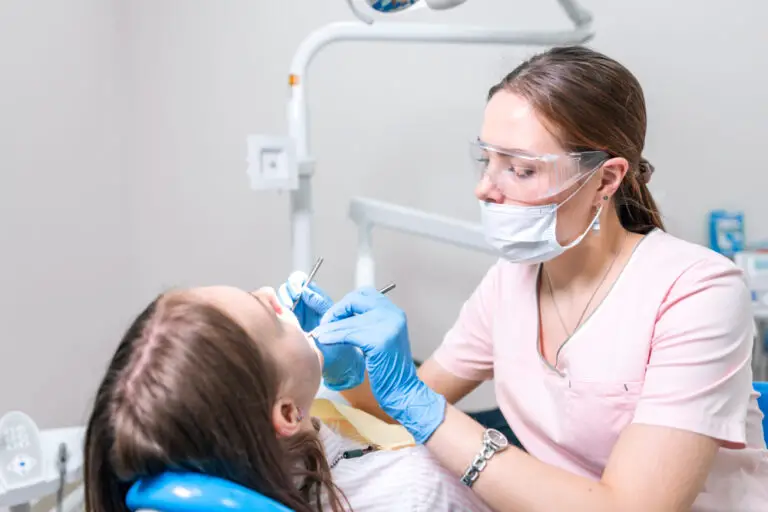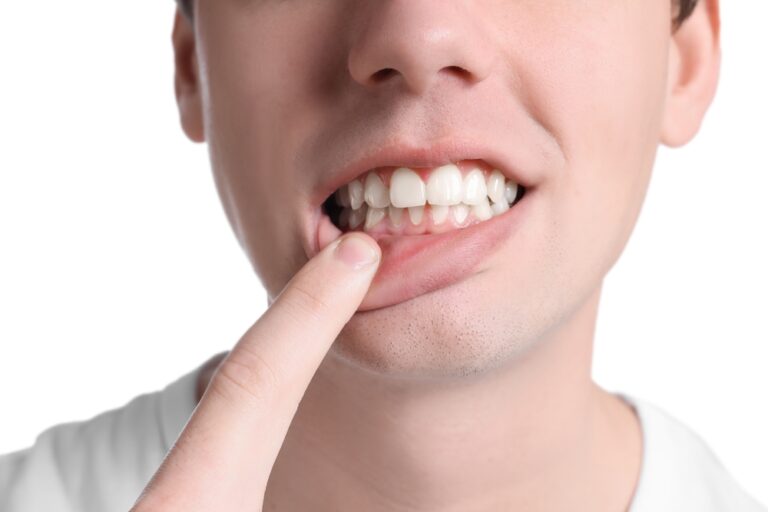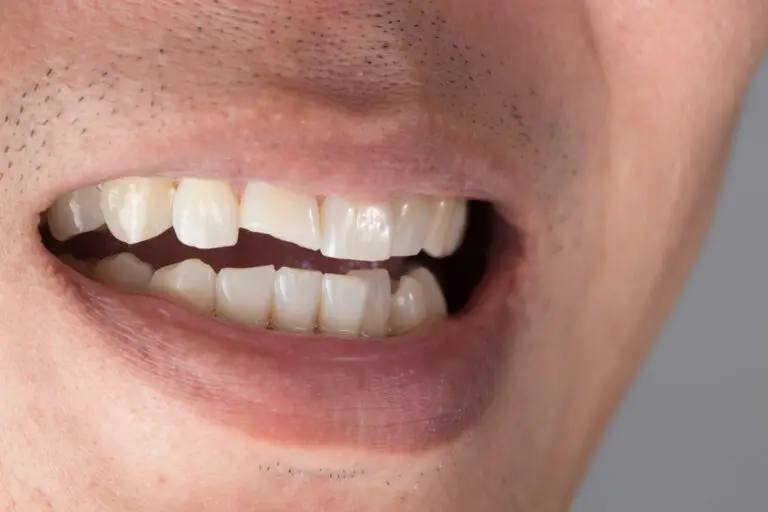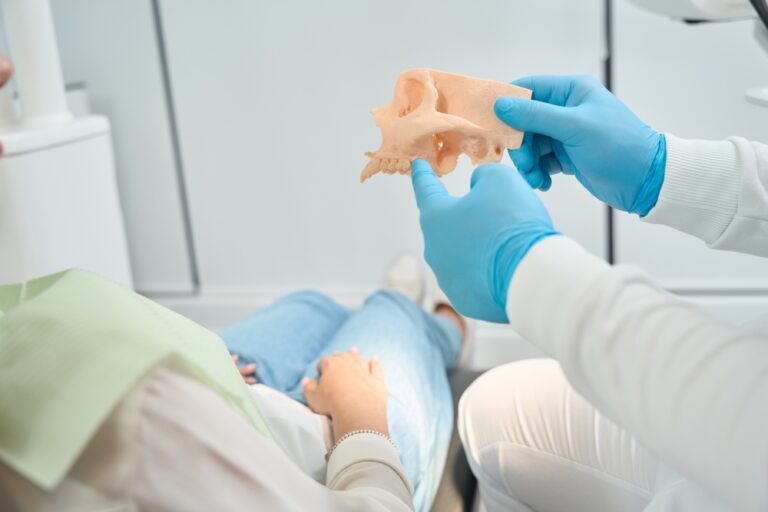Having pain between two teeth where the gums are located can be uncomfortable and concerning. The gums are vital for maintaining healthy teeth. When gum pain develops, it is usually a sign of an underlying issue that needs to be addressed. Understanding the possible causes and treatments can help provide relief.
What Causes Gum Pain Between Teeth?
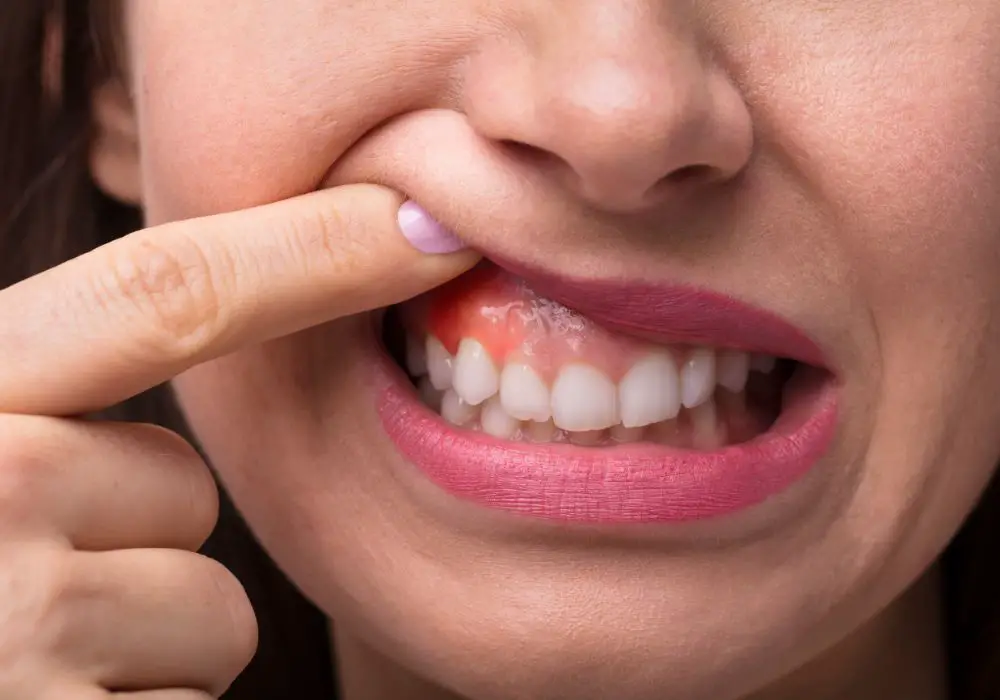
There are several potential explanations for sore gums between two teeth:
Gingivitis
Gingivitis is inflammation of the gums caused by a bacterial infection. When plaque builds up on teeth it can irritate the gums and cause them to become inflamed. Gingivitis commonly causes red, swollen gums that may bleed easily when brushing or flossing. The inflammation can be localized between two teeth or affect the entire gumline.
Periodontitis
Periodontitis is a more serious form of gum disease that damages the soft tissue and destroys the bone that supports teeth. Like gingivitis, it is caused by plaque buildup. However, in periodontitis the infection spreads deeper below the gumline. This can cause painful pockets to form between teeth.
Trauma
Injury to the gums from rough brushing, flossing, or biting on hard foods can lead to soreness between teeth. Cuts, abrasions and bruising of the gums may occur, resulting in localized pain.
Food Impaction
When food particles become trapped between teeth it can put pressure on the gums and cause pain and inflammation. This commonly occurs with seeds, popcorn kernels, or pieces of meat lodged between teeth.
Tooth Grinding
Excessive grinding or clenching of teeth, known as bruxism, can traumatize the gums. This may cause gums between two teeth to become sore and irritated.
Gum Recession
As gums recede due to gum disease or natural aging, more of the tooth’s root becomes exposed. This can make the gums between teeth more sensitive and prone to pain.
Dental Abscess
A bacterial infection in the tooth’s root or between two teeth can cause a dental abscess. Abscesses cause throbbing pain, swelling, and sensitivity between affected teeth.
When to See a Dentist
It’s important to make an appointment with a dentist for an examination if gums remain painful for more than 2-3 days. While gum pain may seem minor, it can indicate a significant problem that will only worsen without treatment. Ignoring the symptoms and delaying necessary dental care increases the chance of permanent tooth and gum damage.
Diagnosis at the Dentist

A dentist will perform a clinical exam and ask about symptoms to determine the cause of painful gums between teeth. As part of the exam, the dentist will check for:
- Redness, swelling, or bleeding of gums
- Periodontal pockets around teeth
- Loose teeth
- Damage to gum tissue
- Signs of bruxism like worn enamel
- Cavities or tooth defects
- Swelling indicating an abscess
The dentist may probe the gums and measure gum pockets to assess the health of the gums and supporting structures. X-rays are often used to check for bone loss and deep infections. With an accurate diagnosis, appropriate treatment can proceed.
Gum Pain Relief and Treatment Options
Treatment will focus on resolving the cause of the gum pain for lasting relief. Options may include:
Improved Oral Hygiene
This is the first line of defense. Thorough brushing and flossing twice daily will remove plaque that irritates the gums. An antiseptic mouthwash can also reduce bacteria. Regular cleanings by a hygienist will prevent plaque buildup.
Antibiotics
For bacterial infections causing gingivitis or abscesses, antibiotics may be prescribed to eliminate bacteria and reduce inflammation.
Deep Cleaning
A dentist or hygienist may need to perform a deep cleaning below the gumline, called scaling and root planing. This removes tartar and plaque that brushing doesn’t reach.
Gum Surgery
Surgical procedures like flap surgery and bone or tissue grafts can correct gum recession between teeth. This removes infection and covers exposed roots to prevent sensitivity.
Medicated Chip Treatment
A small medicated chip can be placed between teeth to gradually release antimicrobial medication to the gum over several months. This can help treat localized gum disease.
Orthodontic Adjustment
Realigning teeth with orthodontics can ease pressure on gums between teeth caused by misalignment.
Mouthguards and Night Guards
These devices cushion teeth and prevent grinding that can traumatize gums. They protect the gums between teeth while sleeping or playing sports.
Properly treating gum pain provides long-term relief. Good oral hygiene and routine dental cleanings are key to preventing recurrent problems. Seeking prompt care when gums hurt can minimize permanent damage. Healthy gums are critical to oral health and keeping natural teeth.
What Can I Do to Prevent Pain Between Teeth?

While gum pain sometimes can’t be avoided, these self-care tips can reduce the chances of developing sore gums between your teeth:
Brush twice daily – Regular brushing prevents plaque buildup that causes gum inflammation. Use a soft-bristled brush and brush for 2 minutes each time.
Floss daily – Flossing removes plaque and food debris between teeth that irritates gums. Curve the floss around each tooth.
Use antiseptic rinses – Rinsing daily with an antiseptic mouthwash like one containing cetylpyridinium chloride can reduce bacteria.
Eat a balanced diet – Eating a variety of fruits and vegetables can provide nutrients for healthier gums. Stay hydrated by drinking plenty of water.
Quit smoking – Smoking increases the risk of gum disease and infection between teeth. The chemicals in smoke irritate gums.
Avoid frequent snacking – Constant snacking provides more opportunities for cavities and food to get stuck between teeth. Limit snacks and stick to meal times.
Get regular dental cleanings – Professional cleanings every 6 months prevent plaque buildup and remove hardened tartar you can’t brush away.
Use a night guard if grinding teeth – Wearing a mouth guard at night will protect gums from damage if you grind your teeth. Ask your dentist about options.
Watch for signs of gum disease – Red, swollen, painful gums that bleed easily may indicate gum disease. See your dentist right away.
Get gum problems treated quickly – Prompt professional treatment can resolve gum infections and other issues before they worsen.
Following healthy oral hygiene habits reduces the likelihood of developing gum pain between your teeth. But if gum soreness does occur, seek dental care for proper treatment and relief. Maintaining healthy gums helps keep your teeth in good condition.
Natural Remedies to Soothe Sore Gums Between Teeth
In addition to professional dental treatment, you can try using natural remedies at home to temporarily relieve discomfort from sore gums between teeth:
- Salt water rinse – Mix 1 teaspoon salt in a cup of warm water and swish it around your mouth. Salt water helps reduce inflammation.
- Aloe vera gel – Known for its soothing properties, aloe vera gel can be directly applied to irritated gums.
- Green tea bags – Soak a green tea bag in warm water, then press it against painful gums. The antioxidants help reduce inflammation.
- Cold compress – Applying a cold compress to swollen, painful gums can provide relief. Wrap ice in a cloth and hold it on the area for up to 20 minutes.
- Clove oil – Having antimicrobial properties, clove oil applied to gums may temporarily numb pain when dabbed on with a cotton swab.
- Turmeric paste – Make a paste with turmeric powder and water. Turmeric contains curcumin which has anti-inflammatory effects. Gently rub the paste on inflamed gums.
- Guava leaves – Chewing on fresh guava leaves releases pain-relieving compounds. Simply chew the leaf and press it against painful gums.
While home remedies can temporarily help symptoms, they do not treat the underlying cause of gum pain. See your dentist to address the source of the problem and improve oral health.
Common Questions About Painful Gums Between Teeth
Pain between teeth where they meet the gums can be worrying. Here are answers to some frequently asked questions about sore gums between teeth.
Is gum pain between two teeth serious?
Gum pain is usually a sign of infection or inflammation, which if left untreated can lead to permanent gum and bone damage. While it may start with minor symptoms, gum disease can become severe over time. It’s important to see a dentist promptly for an evaluation of jaw pain between teeth.
Can gum pain between teeth be from sinus pressure?
It’s unlikely that gum pain results from sinus pressure. The sinuses are located above the upper teeth, not between the teeth. More commonly, it is a dental issue like gingivitis, periodontitis, or trauma causing sore gums between teeth. However, a sinus infection may create generalized tooth discomfort.
What does it mean if one gum hurts between two teeth?
When the gum pain is confined to one area between two teeth, it suggests a localized cause like food impaction, gum recession, or a dental abscess affecting the specific site. Gum disease like gingivitis more typically causes uniform gum inflammation. Focused pain warrants prompt dental examination.
Is gum pain between front teeth normal with braces?
Some mild soreness after adjustments is normal, but intense or persistent gum pain between front teeth while wearing braces is not. It may signal improper orthodontic force on the teeth and gums. See your orthodontist to adjust the braces and relieve pressure on teeth and gums.
Can gum pain between teeth be from pregnancy?
Pregnancy gingivitis can cause inflamed, tender gums due to hormone changes. Gums may bleed and become painful between teeth as a result. Practicing good oral hygiene and informing your dentist about pregnancy can help control gum inflammation. Get any dental treatment needed before the third trimester.
Seeing a dentist promptly when gums hurt between teeth allows for proper diagnosis and the right treatment to resolve the issue. Left untreated, gum pain can escalate into major oral health problems. Addressing symptoms quickly leads to the best outcome and prevents unnecessary complications.
Conclusion
Gum pain between teeth is usually a warning sign not to ignore. While the discomfort may seem minor at first, it often indicates infection or inflammation that will worsen over time without proper treatment. The most common causes include gingivitis, periodontitis, trauma, food impaction, grinding, and gum recession. Seeing a dentist right away for an exam and accurate diagnosis is important, before permanent damage can occur. Based on the diagnosed problem, typical treatments may involve improved oral hygiene, antibiotics, deep cleanings, gum surgery, orthodontics adjustments, or mouthguards. To help prevent gum problems, it’s essential to maintain excellent daily brushing and flossing habits. Paying attention to gum health and seeking prompt care for any symptoms can keep gums in optimal condition and prevent needless complications. Healthy gums support strong, well-functioning teeth essential for a lifetime of chewing and smiling.


